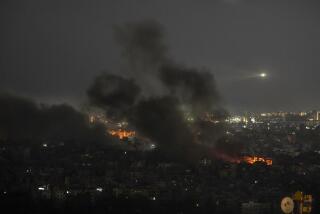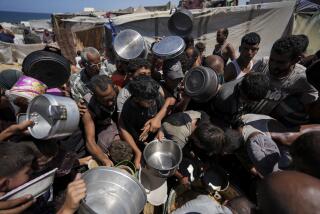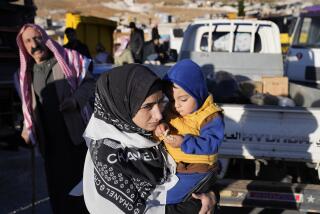Syria border fighting sends 8,000 fleeing to Turkey
BEIRUT — Fierce fighting in a border town in northeastern Syrian sent about 8,000 people fleeing into neighboring Turkey over a 24-hour period, one of the largest single-day surges of refugees since the Syrian conflict began, officials said Friday.
Driving the sudden exodus that began Thursday was intense fighting in the northeastern Syrian border city of Ras Ayn, where rebels were reported to have seized security compounds and occupied much of the town. Panicked civilians fled en masse, dodging gunfire and shelling and in some cases struggling to get through barbed-wire fences along the frontier.
The situation dramatized again how Syria’s escalating internal conflict is spilling over its borders, threatening to destabilize neighboring nations whose leaders are alarmed by the upheaval.
Overall, about 11,000 refugees poured out of Syria in a 24-hour period beginning Thursday, the United Nations said Friday.
Most were trying to escape the fighting in Ras Ayn. But 1,000 fled into Turkey because of violence farther west, in Syria’s Idlib province, and 2,000 crossed into Jordan and Lebanon, the U.N. said.
Turkey is now sheltering more than 120,000 Syrian refugees, well beyond the 100,000 total that Ankara had said would be its limit.
“How far will this go?” asked a frustrated Turkish Prime Minister Recep Tayyip Erdogan, who was on a trip to Indonesia. His comments were reported on the website of the Turkish newspaper Today’s Zaman.
Turkish officials have lobbied, without success, for the establishment of an internationally protected buffer zone inside Syria where war refugees could find a haven. But the United States and other nations are hesitant to make the military commitment that would be essential to securing protected territory.
Meanwhile, in the Persian Gulf nation of Qatar, Syria’s best-known opposition group, the Syrian National Council, said it had elected veteran Christian dissident George Sabra as its president. The umbrella group — which critics say is dominated by the Islamist Muslim Brotherhood — is struggling to show that it is representative of Syria’s minority communities, including Christians, Kurds and Alawites, the Shiite sect that includes President Bashar Assad and many of his top security chiefs.
But U.S. officials have called for the sidelining of the Syrian National Council and the creation of a broader organization that could serve as an effective government in exile. Deep divisions have plagued the Syrian opposition, frustrating the U.S. and other nations pushing for a unified, coherent front against Assad.
The border clash pushing thousands of Syrians into Turkey on Thursday and Friday took place in isolated Hasaka province, a relatively new front in the almost 20-month Syrian conflict. The province is home to the largest concentration of Syrian Kurds, who have had an uneasy relationship with the overwhelmingly Arab rebel forces seeking to overthrow Assad.
The border city of Ras Ayn, once home to more than 60,000 people, was said to be largely deserted Friday because of street fighting and shelling by government troops, who reportedly fled the center of town along with the residents.
“It is a ghost town,” said an activist reached in the area.
Reports indicated that rebels controlled much of Ras Ayn, but military units based outside continued to lob shells into the city.
Video posted online purported to show rebels raising the opposition tricolor atop a major security building in the center of town.
Another video showed what appeared to be more than a dozen soldiers being held prisoner, apparently in a public building, as a rebel officer read to them from the Koran. Other reports indicated that a top provincial official may have been among those captured.
The video images could not be independently verified, and casualty figures from the fighting were unclear.
At least 20 soldiers were killed in the battle for Ras Ayn, according to the British-based Syrian Observatory for Human Rights, a pro-opposition group.
The Friday exodus was more than triple the usual 2,000 to 3,000 people escaping from Syria daily, said Sybella Wilkes, spokeswoman for the U.N. refugee agency. Scores who fled were wounded and at least two died, she said.
“The numbers are increasing by the hour,” Wilkes said. “The Turkish government says it can take weeks or even months to build a camp. But it can take only hours to fill them.”
The official Anadolu news agency in Turkey reported more than two dozen Syrian soldiers, including two generals, were among the throngs fleeing to Turkey with their families.
More than 500,000 Syrians have fled their homeland since the fighting began, according to various estimates, and 1.5 million have been displaced in Syria.
Aid groups have estimated that the number of people in need of aid in Syria could reach 4 million by early next year, up from about 2.5 million now.
On Thursday, the International Committee of the Red Cross said it was unable to cope with the growing demand for assistance in Syria.
As winter draws nearer, the U.N. refugee agency and other aid organizations are alarmed to have received only 35% of the approximately $500 million needed to help Syrian refugees scattered across the region.
“We need to winterize tents, to get heaters and extra blankets,” Wilkes said. “We’re not looking at luxury. We’re looking at life-saving support here.”
The desperation is evident in several neighboring nations. At the Zaatari camp in Jordan, Syrian women told the World Food Program that they had gone without food for two days while trying to reach the border. Iraq, still reeling after its own bloody war, now has close to 50,000 Syrian refugees, the U.N. estimates.
Marrouch is a special correspondent.
Times staff writer Emily Alpert in Los Angeles contributed to this report.
More to Read
Sign up for Essential California
The most important California stories and recommendations in your inbox every morning.
You may occasionally receive promotional content from the Los Angeles Times.










